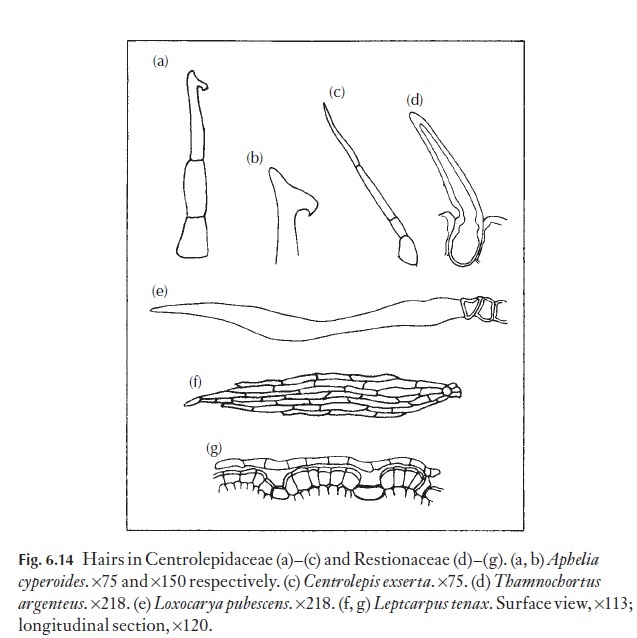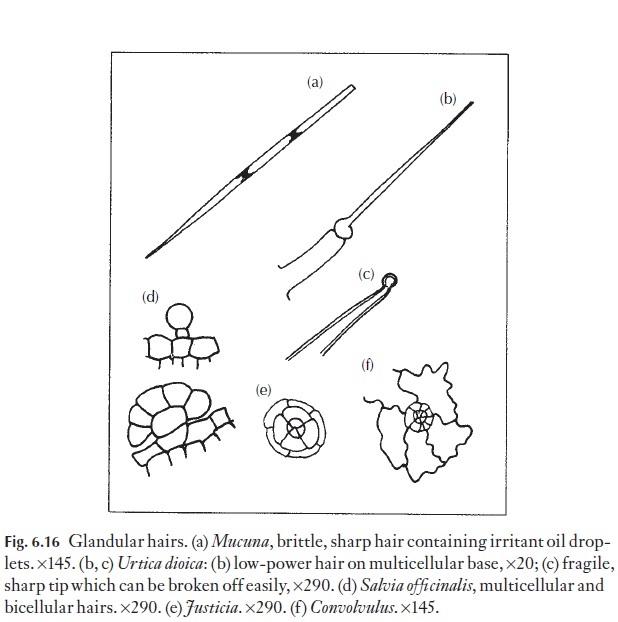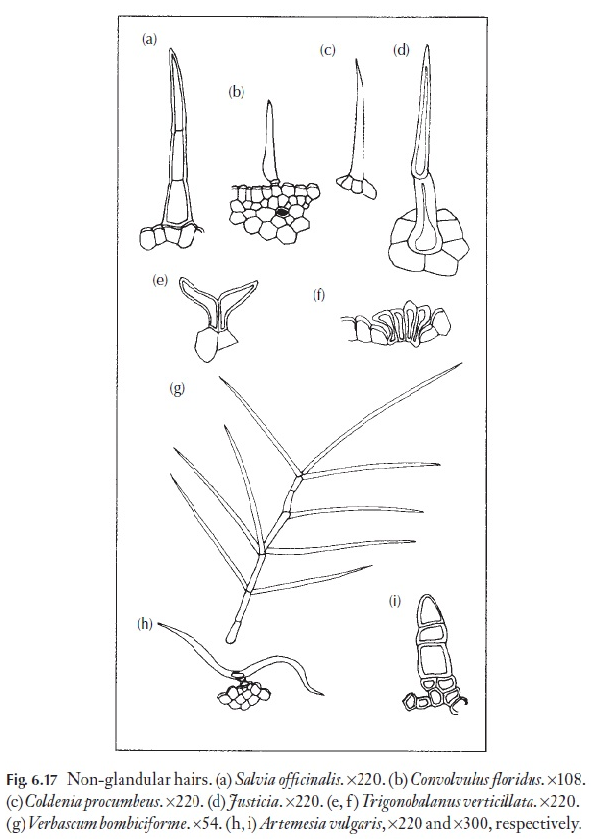Chapter: Plant Anatomy:An Applied Approach: The leaf
Trichomes - The leaf
Trichomes
Hairs and papillae (and scales) are collectively called trichomes. Taxono-mists use their occurrence and cellular structure extensively as an aid to identification, because there is such a wide range of form. When a plant possesses hairs or papillae, they are usually of a type or types charac-teristic of that species. It should be noted that various samples of a plant of a given species may range from being glabrous (hairless) to very hirsute (hairy). This means that the numbers and density of hairs can be a poor character to use taxonomically, except, perhaps, in defining subspecies or varieties, if there are other, linked characters to support those divisions. Also, although hairs are so diverse in form, there are very few types that can be used even in the diagnosis of a family, that is, are of taxonomic significance.
The greatest value of hairs is in identification, that is, they have high di-agnostic value. They are constant in a species when present, or show a con-stant range of form. Consequently, small fragments of leaf with hairs can often be matched with known material. If you look at the descriptions of powdered drugs of leaf origin in the European Pharmacopoea or your national pharmacopoea you will see the hairs carefully defined. Examina-tion of hair types can help in quality control, for example of dried herbs, like mint, where cheaper substitutes may have been added (Fig. 6.15).

In some families, individual species can be defined on the form of their hairs alone. Among these are Restionaceae and Centrolepidaceae which show good examples of simple, unbranched hairs (Fig. 6.14). The relative sizes of the basal cell and the cells of the free portion vary from species to species. The curious ‘boathook’ end of the cell in Aphelia cyperoides is diag-nostic. Gaimardia has complex, branching filamentous hairs.

In the Restionaceae, Leptocarpus from Australia, New Zealand, Malaysia and South America, flattened, shield-shaped stem hairs occur. These hairs are multicellular, diamond-shaped plates, held closely to the surface of the stem on short, sunken stalks as shown in Fig. 6.14. Until recently it was thought that Leptocarpus also occurred in South Africa, but the hair type and other internal histological differences show that the South African plants really belong to a distinct genus, which at that stage in the investiga-tion, had not been named. A close relative to Leptocarpus in Australia is Meeboldina, which have diamond-form hairs, and two large, thin-walledtranslucent central cells, together with a border of thick-walled cells withrecurved micropapillae which effectively zip adjacent hairs together so that they will strip off in a sheet if you try to pull one away.

Some plants have hairs on both upper and lower surfaces but in many cases they are confined to the lower surface. Examples of leaves with hairs on both surfaces are to be found among the silver-leaved composites. The air in the hairs masks the chlorophyll in the leaf, giving a highly refractive, silvery or white appearance.
Hairs are divided into two major categories, the glandular and non-glandular (or covering) hairs. Glandular hairs (Fig. 6.16) include the sting-ing hairs of plants like the nettle, Urtica. Less familiar are the irritant hairs from the pods of Mucuna, the ‘cowitch’ (Fabaceae), from the West Indies (Fig. 6.16a).
Simple glandular hairs are present on the leaves of plants that can trap and digest small insects and other small animals. Some of these are sticky, and some specialized to secrete digestive enzymes. Pinguiculaand Drosera are examples.

Some of the fragrant (or less pleasant) essential oils occur in glandular hairs or leaves. The non-glandular hairs are much more varied and diverse than the glandular. A range of types are illustrated in Fig. 6.17, and the plants on which they occur are identified in the caption. One or more of these plants or its relatives should grow near your home. The larger hairs will be visible with a hand lens.
As mentioned earlier, usually the hair type is only one of many characters that may be used in identification. However, some families are easily recog-nized by their hairs, for example the T-shaped hairs of Malpighiaceae (Fig. 6.17h). Rhododendrons have been classified on the basis of leaf hairs, as an aid to the identification of species. Here, not only form, but also hair colour is used in the keys.
Microhairs are very short, two-celled hairs that are present on the leaves of some grasses, mostly from the tropics. Prickle hairs, which are usually prominent on margins and veins of grasses, are normally unicellular. They have thick walls that can be silicified. This is why it is easy to cut your hands on some grasses, and why cattle are selective in their grazing.
A number of hairs are of commercial value. These are not leaf hairs, but usually come from the fruit or seed, for example cotton (Gossypium) and kapok (Bombax).
The function of hairs is generally thought to be related to the water rela-tions of a leaf. A densely hairy surface would tend to restrict the rate of flow of drying air. In xerophytes, hairs frequently have a suberin band in the wall towards their base. This prevents water leakage from the leaf through the cell wall of the hairs (apoplastic movement). Hairs, of course, increase con-siderably the potential surface area for evaporation. The converse require-ment is true of hairs on epiphytes like Tillandsia (Bromeliaceae). In these plants, which are not rooted in the ground, the hairs are able to absorb water from rain or mist. They lack suberin bands. It is easy to test for ‘waterproof’
hairs. A piece of hairy leaf surface is cut carefully from a leaf and floated on a Petri dish containing a solution of calcofluor white for an hour, then re-moved and viewed in UV light (while wearing protective goggles). If there are suberin bands, the hairs will not fluoresce. If bands are absent, the hairs will fluoresce brightly. However, other hairs seem to have primarily an anti-herbivore function as in the grasses described above.
Scales have a wide base, are usually one to a few cell layers thick, and lack any vascular tissue. Their form, size and position can be used diagnosti-cally. They are frequent on fern fronds.
Related Topics